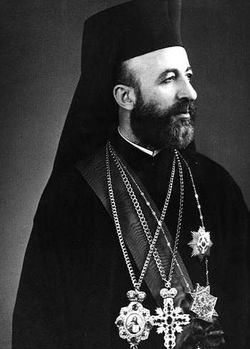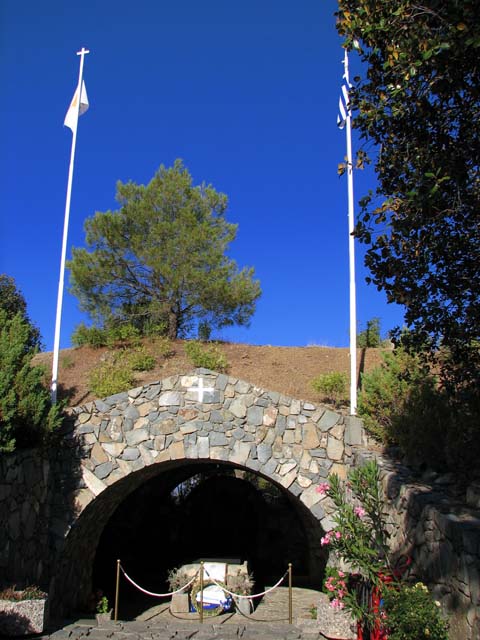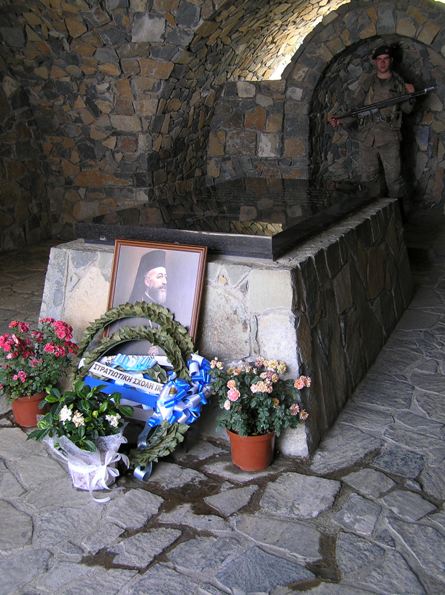Religious Figure, Politician. He gained international attention for his participation in the conflict called the Cyprus Emergency, which started on April 1, 1955. He was deported for this action by the British Governor of Cyprus, John Harding, to Mahe Island in the Seychelles on March 9, 1956, returning in 1959 after Cyprus gained independence from Britain. Politically, he served as the first President of Cyprus between 1960 and 1977. He was also the Archbishop of the autocephalous Church of Cyprus from 1950 to 1977. He was not only the religious leader of Cyprus, but he was also the political leader or politico-religious. For years, his administration was marred by fighting and unstable government. He was born Mikhail Khristodolou Mouskos in Pano Panayia, Paphos, Cyprus, on August 13, 1913. At the age of 13, he became a monk. He adopted the name "Makarios." During World War II, he studied theology and law at the University of Athens, graduating in 1942, and later, from 1947 to 1948, he studied at Boston University in Massachusetts. He became a priest in 1946. In 1950, upon the death of Makarios II, he was made national leader of Cyprus. In 1955, the guerrilla group National Organization of Cyprus Struggle opened a violent campaign to break off Cyprus's British Union rule and join Greece. He survived four assassination attempts. In 1972 and 1973, he was asked for his resignation but refused. He went into exile again in 1974 after a military coup d'état, yet returned to Cyprus, where he died of a heart attack on August 3, 1977. Originally, the Makarios Statue was situated at the Archbishop's Palace in Nicosia but was relocated to Vouni in 2008. Another statue of Archbishop Makarios III was erected near the Kykkos Monastery, and several more throughout Cyprus. While some refer to him as a great charismatic statesman, his critics called him a dictator, "the Fidel Castro of the Mediterranean."
Religious Figure, Politician. He gained international attention for his participation in the conflict called the Cyprus Emergency, which started on April 1, 1955. He was deported for this action by the British Governor of Cyprus, John Harding, to Mahe Island in the Seychelles on March 9, 1956, returning in 1959 after Cyprus gained independence from Britain. Politically, he served as the first President of Cyprus between 1960 and 1977. He was also the Archbishop of the autocephalous Church of Cyprus from 1950 to 1977. He was not only the religious leader of Cyprus, but he was also the political leader or politico-religious. For years, his administration was marred by fighting and unstable government. He was born Mikhail Khristodolou Mouskos in Pano Panayia, Paphos, Cyprus, on August 13, 1913. At the age of 13, he became a monk. He adopted the name "Makarios." During World War II, he studied theology and law at the University of Athens, graduating in 1942, and later, from 1947 to 1948, he studied at Boston University in Massachusetts. He became a priest in 1946. In 1950, upon the death of Makarios II, he was made national leader of Cyprus. In 1955, the guerrilla group National Organization of Cyprus Struggle opened a violent campaign to break off Cyprus's British Union rule and join Greece. He survived four assassination attempts. In 1972 and 1973, he was asked for his resignation but refused. He went into exile again in 1974 after a military coup d'état, yet returned to Cyprus, where he died of a heart attack on August 3, 1977. Originally, the Makarios Statue was situated at the Archbishop's Palace in Nicosia but was relocated to Vouni in 2008. Another statue of Archbishop Makarios III was erected near the Kykkos Monastery, and several more throughout Cyprus. While some refer to him as a great charismatic statesman, his critics called him a dictator, "the Fidel Castro of the Mediterranean."
Bio by: Linda Davis
Advertisement
See more Makarios memorials in:
Advertisement




